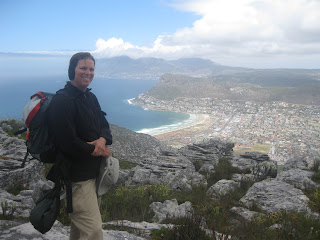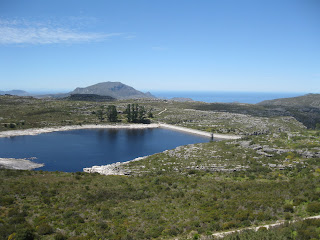 |
| riverine vegetation along Silvermine Dam stream |
 |
| loved how this old tree was growing out over the water--enchanting |
On Wednesday this week, 12/29, I hiked over a ridge and into a different river valley. I’m always amazed that I can leave my sunny little area of Silvermine River Valley, begin climbing a mountain range, and find myself shrouded in mist, high winds, and COLD. And this is what happened when I hiked yesterday. Often, when I come back down from the mountain ridge and into a valley, the sun and all its glory is beaming upon me—but not then. I hiked to the Silvermine Dam because I read that it was a lovely area of the park holding a nice, beautiful, calm body of water. (They call “lakes” here in South Africa “dams,” but probably because most lakes here are caused by man-made dams.) And I’m sure it is a lovely sight to see, but I didn’t see it, because it was shrouded in mist. But it was an interesting walk anyway, even if it did feel like Mount Everest on the ridge top.
I guess there are kooks all over the world, but nonetheless, I’m always startled when I meet one. On my way out of my area of the park, I met one. He was gathering, so it seemed, samples of the roadside vegetation (but definitely PARK vegetation) and I thought to myself: Boy, if I were on ranger patrol, you would get it! As we passed, we made eye contact and he became all the more excited asking if I were an American. (I must have a florescent-pink neon-sign bolted to my forehead that flashes “American! American!” because no matter where I am in South Africa, everyone seems to know I’m American.) When I nodded in affirmative that yes, I was indeed American, he practically twirled in delight and fell into a monologue about how he was just thinking about that wonderful Dick Cheney and how Dick Cheney bravely watched as the planes crashed into our towers. By this time, we had passed, I had turned around and was walking backwards, as to hold eye contact and not be rude so that we could continue “our” conversation. (He was the only one conversing, but I had a fake, clown-like smile pasted to my face and was nodding slightly in the affirmative.) However, I’m wary and on alert now, as I am not now, nor was I ever, a fan of Dick Cheney. The kook continued to beam about how happy he was that the Americans were finally ousting that Muslim president, Obama. I thought to myself, “Ok, that’s it. He’s a nutcase--no politeness required.” I turned around to leave him and walked myself right into a steel fence post which caused bleeding on my hand and a butternut squash-sized bruise on the top of my thigh. Big sigh. So much for trying to be nice to nutcases.
I would soon meet another kooky character, but kooky character in a kind, giggly, other-worldly way, rather than in a nut bar, insane kind of way. When I reached my destination of Silvermine Dam (or in other words, the lake), I began the lovely walk about, that I could not see (because the water and its banks were shrouded in mist), and I passed a lovely young woman on the path smiling largely. After she passed, I heard a couple of faint “ahems” and I turned to her. She whispered gleefully, that just ahead was a wonderful spot for skinny dipping--if I were into that kind of thing. Now, I’m not saying I’m not into skinny dipping, but I was wearing my coat, my hat pulled tightly about my head, earmuffs, and GLOVES. I wonder what it was about me that she would think I might enjoy a skinny dip? I was freezing cold, wet, and grumpy!! Even her delight could not cheer me.
It was an interesting day overall and I was grateful to have overcome my Capetonian version of Mt. Everest (twice!--in my coming and in my going) and to have managed my kooky encounters!
Soon,
Karen
 |
| a pinker variety of watsonia |
 |
| water lilies |


























































